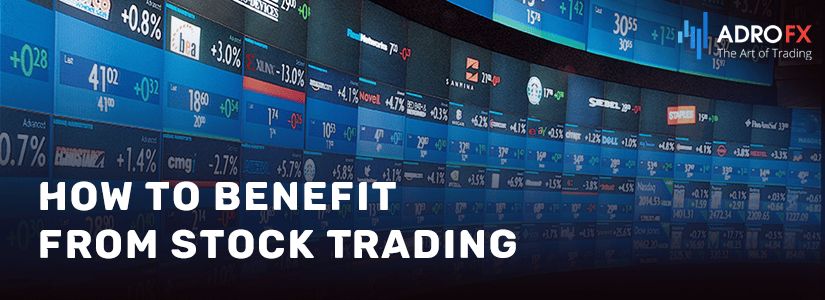How to Benefit from Stock Trading

Have you ever wondered how to generate income trading stocks? If so, it's a very good question. After all, stocks are one of the best ways to build wealth and passive income. Oddly enough, despite this, many other people are afraid of the stock market and hesitate to start investing. They are afraid of the myths that investing in stocks takes a lot of time and capital.
We will debunk these myths and hopefully convince you that investing in the stock market is not only a good idea but also a great opportunity to grow capital. In addition, we will give you a simple guide that you can use to start investing in stocks and start earning.
Why Are People Afraid of Investing in Stocks?
Let's first address the myths that make many people hesitate to buy stocks. These myths cause funds to get stuck in bank accounts that offer very low returns and do nothing to increase wealth.
Here are three myths we will try to debunk:
- Stock trading is only for the rich. An investor needs a lot of funds to trade stocks successfully;
- Stock trading is too difficult for a beginning investor;
- Stock trading takes a lot of time.
Myth — Stock trading is only for the rich

It is a fairly common myth that only wealthy people can benefit from stock trading. This is partly because people associate investing in stocks with billionaires like Warren Buffett.
But did you know that these investors also had to start somewhere, and many of them didn't have a lot when they started? So, how do you invest in stocks if you don't have sufficient capital? Let's take a look.
Take Warren Buffett's advice.
Warren Buffett believes that beginners should start investing in stocks with index funds. That's why you should consider investing in ETFs (exchange-traded stock funds).
What is an ETF? In simple terms, an ETF is a publicly traded fund that invests in stocks from publicly traded indices or specific industries. Buying a stake in an ETF is as easy as buying a regular stock. In addition, they are usually inexpensive.
A simple example. Suppose there is an ETF that invests in the top 10 stocks of the S&P 500. Suppose also that this ETF has 10,000 shares. This means that the owners of the pieces in the ETF collectively invest in the aforementioned stocks. In other words, with an ETF, investors pool their capital to invest in a basket of stocks.
The main advantage of this approach is that it increases diversification, which is a great risk-reduction strategy. In addition, because you're not investing in individual stocks, you often save a lot of funds on commissions.
However, the benefits of investing in ETFs don't end there. When it comes to returns, ETFs are also some of the most efficient investments you can make. For example, one of the most popular Vanguard S&P 500 ETFs available is up more than 100% over the past five years.
That means that if you had invested $1,000 in this ETF back in 2016, you would already have more than $2,000.
Let's also look at how many shares of companies or ETFs in the U.S. market you can buy for as little as $1,000.
As for stocks, let's look at some popular companies and how much stock you can own:
Apple (APPL) — currently trading at about $114 a share so that you can buy 8 shares.
Alphabet (GOOG) — Google's holding company is currently trading at about $2,214 per share. Think the budget won't allow it? It won't. Some brokers, such as AdroFx, offer leverage trading, so you still can benefit from stock trading.
Netflix (NFLX) — currently trading at about $174 a share, so you'll be able to buy 5 shares.
Nike (NKE) — currently trading at about $101 per share, so you'll be able to buy 9 shares.
Microsoft (MSFT) — currently trading at about $248, so you'll be able to buy 4 shares.
Tesla (TSLA) — currently trading at about $694, so you will be able to buy one share.
Visa (V) — is currently trading at about $199, so you will be able to buy 5 shares.
From the above, you can see that you can easily invest in some well-known companies with as little as $1,000 available, and in some cases even less. However, keep in mind that these are just approximate prices and they are subject to change.
With ETFs, the situation is no different. For $1,000 you can buy:
Two stocks in the Vanguard S&P 500 ETF — copies the structure of the S&P 500 Index.
Six shares in the SPDR Gold Shares ETF — invests in gold.
Three shares in the Vanguard Information Technology ETF invests in leading technology companies.
Seventeen shares of the iShares Core Aggressive Allocation ETF.
Nine shares of the iShares MBS ETF.
Sixteen shares of the iShares S&P 500 Growth ETF.
Myth 2 — Stock trading is too difficult

The next myth associated with stock trading is that it is too difficult for regular investors. It arose because ordinary retail investors compare themselves to professional investors and fund managers.
Of course, at the professional level, making consistent returns on stocks and managing large portfolios can be challenging. That's why professionals have the necessary qualifications and experience to acquire the necessary skills.
But do you need special education if you only want to invest your own capital and provide yourself with additional income? No. In fact, you can learn the basics from two or three good books on investing to get you started.
To help you choose the right books, we've compiled a list of investing books that will give you the knowledge you need:
"The Intelligent Investor: The Definitive Book on Value Investing" - Benjamin Graham. It is Warren Buffett's favorite book, often called the bible of the stock market. Although it was first published in 1949, the principles outlined in it are as valuable today as they were then. Essentially, it teaches you how to buy stocks at less than their real value, also known as value investing. And when you learn and master these concepts, you can achieve yield in the stock market without the risk of losing everything on speculation.
"The Little Book of Common Sense Investing" — John S. Bogle. In this book, John S. Bogle, founder of the world's largest investment company, Vanguard Group, explains in detail his strategy for investing in low-cost index funds. With the skills you learn from reading, you'll be able to invest successfully in ETFs.
"A Beginner's Guide to the Stock Market" by Matthew R. Kratter. If you need a solid foundation for trading in the stock market, be sure to read this guide. It guides you through all the steps, from opening a brokerage account to buying your first stocks. It also describes strategies you can use to earn a living from stocks and passive income from your investments.
"One Up on Wall Street" by Peter Lynch. One of the most famous and successful investors of all time, Peter Lynch shows how to outperform professional investors by finding great investment opportunities before they do.
Myth 3 — Stock trading takes a lot of time

The myth is that getting any return from stocks simply takes too much time. Allegedly, you can't be successful in stock trading and investing unless you quit your job and devote all your time to trading. This is simply not true.
In fact, with strategies such as long-term investing and swing trading, you can benefit from stocks and not spend too much time.
Let's take a look at some of the approaches you can use:
- Swing trading. In swing trading, an investor seeks to capitalize on medium-term trends in the price of a particular stock to achieve a yield. The trades usually last from a few days to a few months. As an example, consider Microsoft stock.
- Long-term investing. If you had invested in Apple stock two years ago, when the price was $57 (considering its 4-for-1 stock split in August 2020), by now, your return would have been more than 200%.
At the same time, you would not need to trade a lot to achieve such a result. - Transferring capital for management. This is where you transfer your funds to a financial advisor or fund manager. As a result, you rely on the skills and experience of the pros to earn without having to do anything.
- Robo-advisors. Similar to financial advisors, robo-advisors allow you to invest without much thought or effort. The difference is that they are digital automated platforms that require little human control.
How to Benefit from Trading Stocks: A Beginner's Guide
Now that you are convinced that you can really get earnings in the stock market without spending a lot of funds and without spending a lot of time managing your investments, it's time to show you how to do it. By following these instructions, you will be able to get started effortlessly.
Step 1: Find the right broker. Although you may think you can use any broker at first, there are pros, cons, and differences between brokers that you need to consider. Ideally, you should think about a broker that offers you a demo account for practice, lower commissions, and lower minimum deposit requirements.
For example, this could be AdroFx - this company works with clients from more than 200 countries, offers a huge selection of stock CFDs, leverages trading, and many other investment options. At the same time, this broker's commissions are some of the lowest on the market.
Step 2: Choose a strategy. The next step is to choose the right strategy to suit your goals, risk appetite, and how much time you want to spend managing your investments. For example, in swing trading, where you seek to benefit from stock price movements, you can nice gains if you catch the trend early. However, in a sideways market, or other words, when there is no trend, swing trading is not as effective and can lead to losses. Conversely, if you invest in an ETF over the long term, you avoid most of the volatility, which reduces risk, but you also often have less returns.
Step 3: Fund your first deposit. Before you can trade, you need to make your first deposit. So, how much should you deposit? As with the strategy you will be using, the amount of your deposit will depend on your specific investment goals and risk appetite. One recommendation, however, is that you should not invest capital you don't want to lose. You should not invest funds you need for other purposes or what you borrowed. Also, another good idea is to gradually increase your investments over time, not only to increase your returns but also to reduce your risk by averaging your dollars.
Step 4: Learn how compound interest works. If you want to increase your returns over time significantly, it's important to know how compound interest works. The concept is simply the process of reinvesting any gains you make. Let's look at a simple example to illustrate this. Let's say you invest $1,000 and can earn a return of 10% per year on your investment. This would result in your total return of $100 in a year. Now, if you reinvest $100, your capital for the next year will be $1100, which means that your return for the second year will be $110 for the same return. If you keep doing this, you will achieve exponential growth in your investment.
How Much Can I Earn Trading Stocks?
How much you can earn in stocks depends on many factors, including market conditions, your strategy, and the amount you invest.
Let's take a look at some expected returns. We looked at the Vanguard S&P 500 ETF above, so let's look at the iShares Core S&P 500 ETF. Here you could get a total return of almost 400% over the last 10 years. That's an average of 40% per annum. So, if you had invested $10,000 10 years ago, you would have $40,000 now.
Similarly, the average stock market return over the last 100 years is 10%. While that's not much, keep in mind that at that rate of return, you would double your investment in 7 years.
What Risks to Consider

Generally, when investing in the stock market, you face some of the following risks:
Price risk. As the name implies, you will always have the risk that the market will turn against your investment. This can happen, for example, when the market as a whole collapses, or when investors buy shares of trending companies, leaving good companies behind.
Economic risk. There is a risk that the overall economy will affect your investments, such as during the 2008 and 2020 financial crises.
Inflation risk. Inflation leads to higher prices and lower currency values. Thus, inflation risk is the risk of losing the value of your investments over time.
While most of these risks are beyond your control, your strategy and the risk management approach you employ are within your control. In other words, you can use the right strategies to mitigate these risks, such as by diversifying your investments.
Conclusion
Buying stocks is one of the best ways to invest funds and accumulate wealth over time. Unfortunately, many people don't invest because they are afraid to do so. We hope this article has helped illustrate three simple truths:
- You don't need a lot of funds to trade stocks;
- You don't need a lot of time to benefit from stocks;
- Earning from stocks is not too difficult.
- More importantly, we have given you a simple guide that you can follow to start investing in the stock market and potentially attain good yields from it.
About AdroFx
Being a well-established brokerage company, AdroFx offers the best trading conditions to its clients from 200 countries. Founded by experts with a couple of decades of overall experience, AdroFx is one of the best platforms on the market for shares trading. Either a newbie or experienced trader, both will find here what they are looking for since the company provides various trading accounts for different trading styles and goals.









